Legal Issues and Consequences for Directors in Breach of Corporations Act
VerifiedAdded on 2023/01/20
|8
|2442
|88
AI Summary
This document discusses the legal issues and consequences faced by directors in breach of the Corporations Act. It explores the concept of separate legal entity and the piercing of the corporate veil. The document also explains the potential actions that can be taken against directors and the possible penalties and disqualifications they may face. It provides relevant case laws and references to support the discussion.
Contribute Materials
Your contribution can guide someone’s learning journey. Share your
documents today.
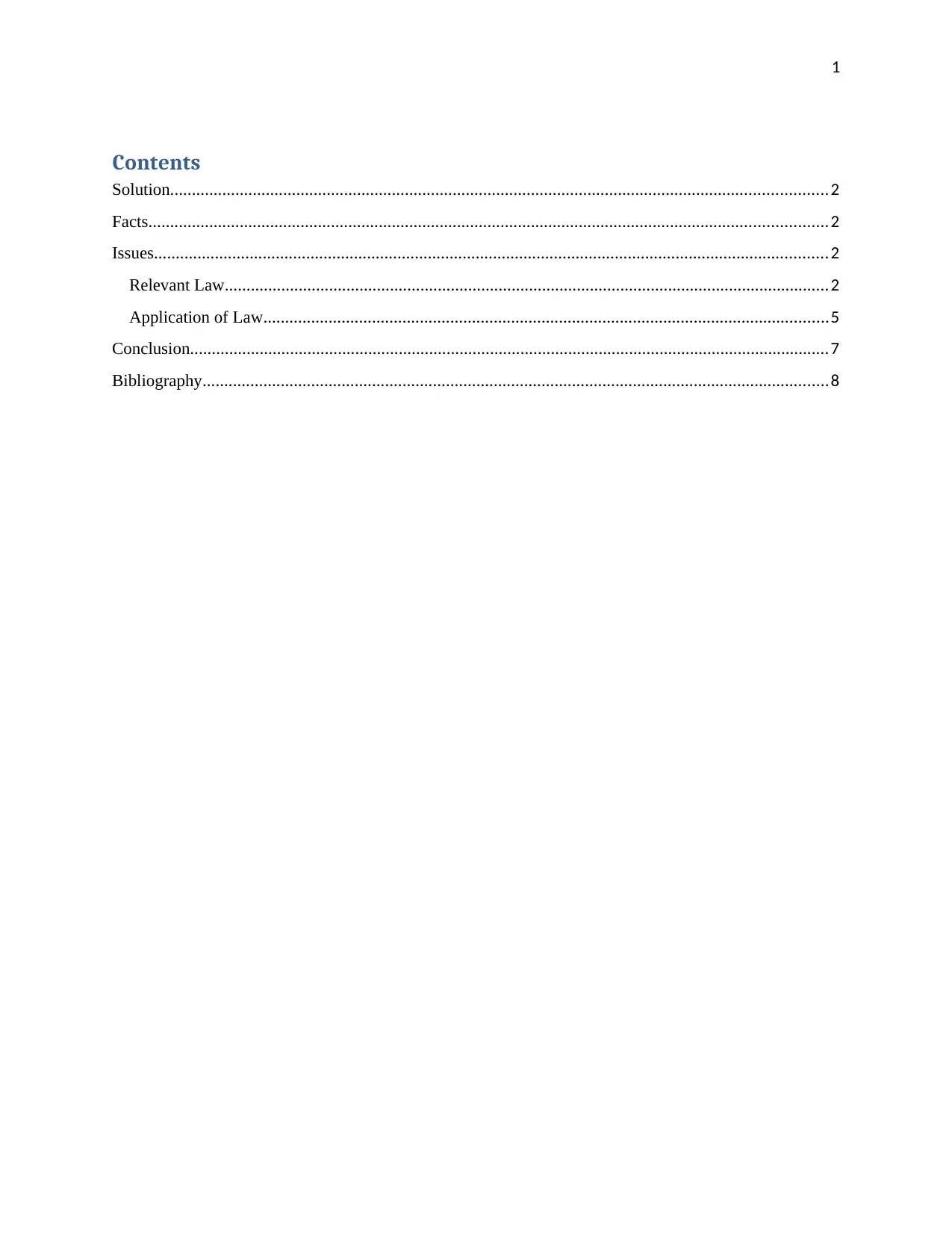
1
Contents
Solution.......................................................................................................................................................2
Facts............................................................................................................................................................2
Issues...........................................................................................................................................................2
Relevant Law...........................................................................................................................................2
Application of Law..................................................................................................................................5
Conclusion...................................................................................................................................................7
Bibliography................................................................................................................................................8
Contents
Solution.......................................................................................................................................................2
Facts............................................................................................................................................................2
Issues...........................................................................................................................................................2
Relevant Law...........................................................................................................................................2
Application of Law..................................................................................................................................5
Conclusion...................................................................................................................................................7
Bibliography................................................................................................................................................8
Secure Best Marks with AI Grader
Need help grading? Try our AI Grader for instant feedback on your assignments.
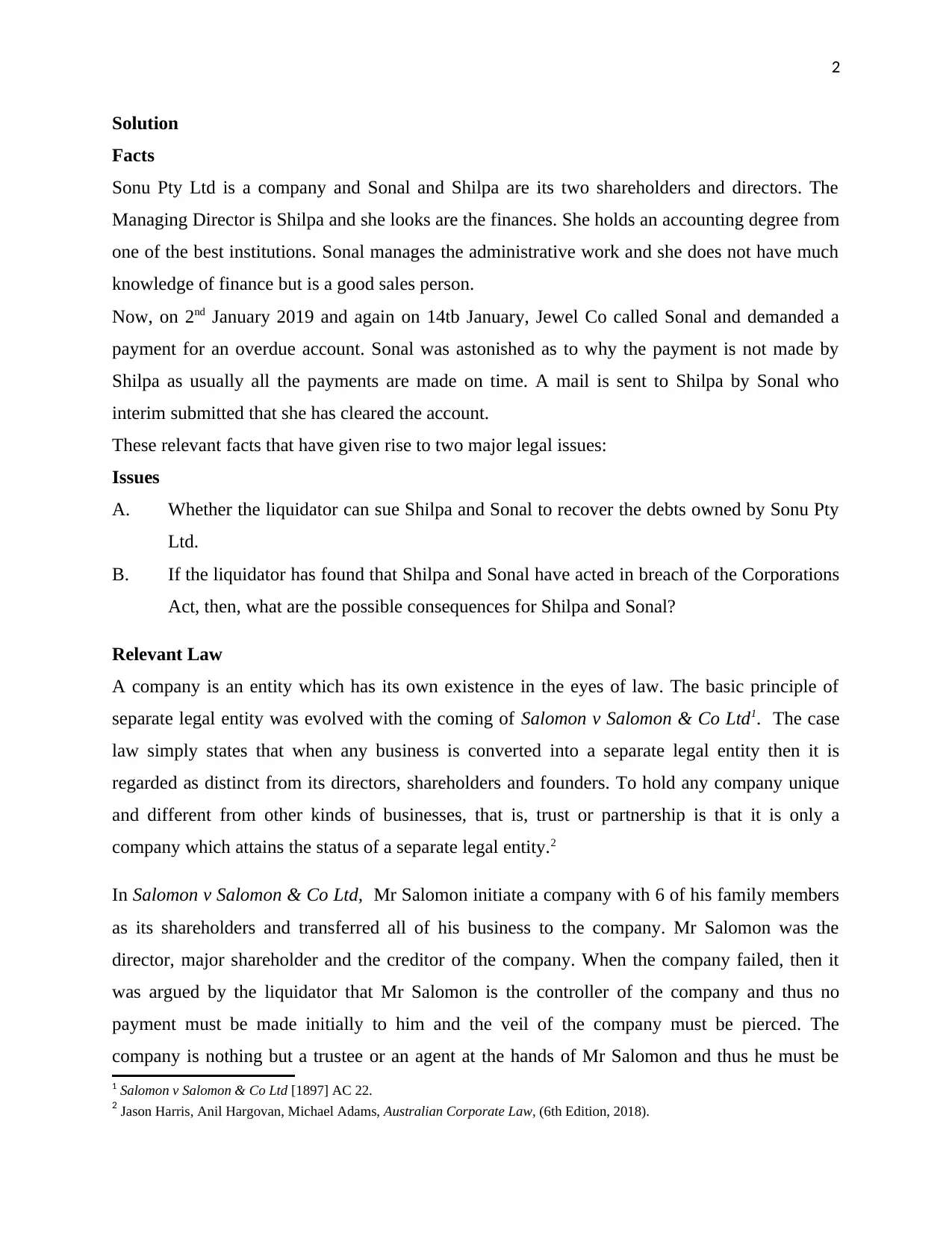
2
Solution
Facts
Sonu Pty Ltd is a company and Sonal and Shilpa are its two shareholders and directors. The
Managing Director is Shilpa and she looks are the finances. She holds an accounting degree from
one of the best institutions. Sonal manages the administrative work and she does not have much
knowledge of finance but is a good sales person.
Now, on 2nd January 2019 and again on 14tb January, Jewel Co called Sonal and demanded a
payment for an overdue account. Sonal was astonished as to why the payment is not made by
Shilpa as usually all the payments are made on time. A mail is sent to Shilpa by Sonal who
interim submitted that she has cleared the account.
These relevant facts that have given rise to two major legal issues:
Issues
A. Whether the liquidator can sue Shilpa and Sonal to recover the debts owned by Sonu Pty
Ltd.
B. If the liquidator has found that Shilpa and Sonal have acted in breach of the Corporations
Act, then, what are the possible consequences for Shilpa and Sonal?
Relevant Law
A company is an entity which has its own existence in the eyes of law. The basic principle of
separate legal entity was evolved with the coming of Salomon v Salomon & Co Ltd1. The case
law simply states that when any business is converted into a separate legal entity then it is
regarded as distinct from its directors, shareholders and founders. To hold any company unique
and different from other kinds of businesses, that is, trust or partnership is that it is only a
company which attains the status of a separate legal entity.2
In Salomon v Salomon & Co Ltd, Mr Salomon initiate a company with 6 of his family members
as its shareholders and transferred all of his business to the company. Mr Salomon was the
director, major shareholder and the creditor of the company. When the company failed, then it
was argued by the liquidator that Mr Salomon is the controller of the company and thus no
payment must be made initially to him and the veil of the company must be pierced. The
company is nothing but a trustee or an agent at the hands of Mr Salomon and thus he must be
1 Salomon v Salomon & Co Ltd [1897] AC 22.
2 Jason Harris, Anil Hargovan, Michael Adams, Australian Corporate Law, (6th Edition, 2018).
Solution
Facts
Sonu Pty Ltd is a company and Sonal and Shilpa are its two shareholders and directors. The
Managing Director is Shilpa and she looks are the finances. She holds an accounting degree from
one of the best institutions. Sonal manages the administrative work and she does not have much
knowledge of finance but is a good sales person.
Now, on 2nd January 2019 and again on 14tb January, Jewel Co called Sonal and demanded a
payment for an overdue account. Sonal was astonished as to why the payment is not made by
Shilpa as usually all the payments are made on time. A mail is sent to Shilpa by Sonal who
interim submitted that she has cleared the account.
These relevant facts that have given rise to two major legal issues:
Issues
A. Whether the liquidator can sue Shilpa and Sonal to recover the debts owned by Sonu Pty
Ltd.
B. If the liquidator has found that Shilpa and Sonal have acted in breach of the Corporations
Act, then, what are the possible consequences for Shilpa and Sonal?
Relevant Law
A company is an entity which has its own existence in the eyes of law. The basic principle of
separate legal entity was evolved with the coming of Salomon v Salomon & Co Ltd1. The case
law simply states that when any business is converted into a separate legal entity then it is
regarded as distinct from its directors, shareholders and founders. To hold any company unique
and different from other kinds of businesses, that is, trust or partnership is that it is only a
company which attains the status of a separate legal entity.2
In Salomon v Salomon & Co Ltd, Mr Salomon initiate a company with 6 of his family members
as its shareholders and transferred all of his business to the company. Mr Salomon was the
director, major shareholder and the creditor of the company. When the company failed, then it
was argued by the liquidator that Mr Salomon is the controller of the company and thus no
payment must be made initially to him and the veil of the company must be pierced. The
company is nothing but a trustee or an agent at the hands of Mr Salomon and thus he must be
1 Salomon v Salomon & Co Ltd [1897] AC 22.
2 Jason Harris, Anil Hargovan, Michael Adams, Australian Corporate Law, (6th Edition, 2018).
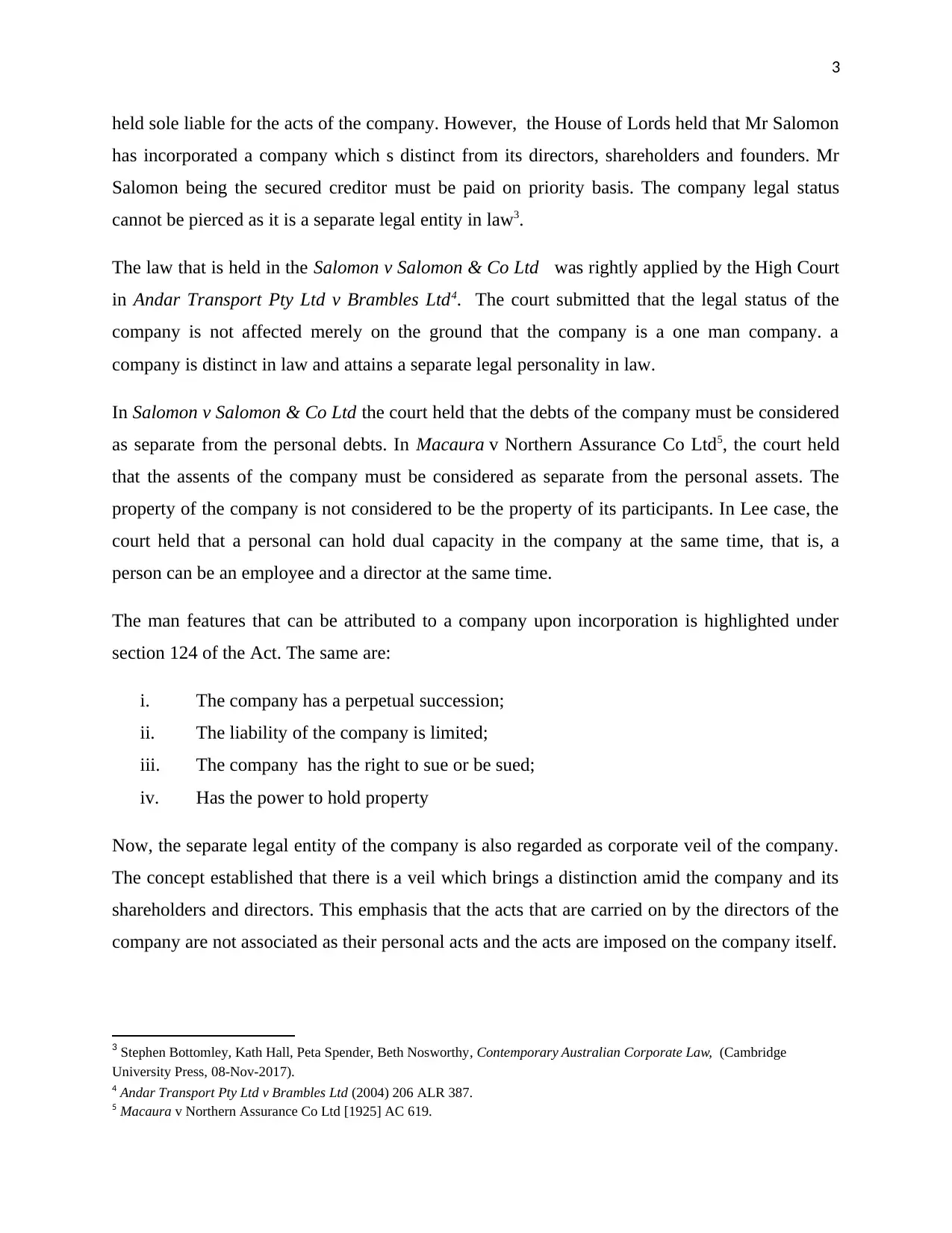
3
held sole liable for the acts of the company. However, the House of Lords held that Mr Salomon
has incorporated a company which s distinct from its directors, shareholders and founders. Mr
Salomon being the secured creditor must be paid on priority basis. The company legal status
cannot be pierced as it is a separate legal entity in law3.
The law that is held in the Salomon v Salomon & Co Ltd was rightly applied by the High Court
in Andar Transport Pty Ltd v Brambles Ltd4. The court submitted that the legal status of the
company is not affected merely on the ground that the company is a one man company. a
company is distinct in law and attains a separate legal personality in law.
In Salomon v Salomon & Co Ltd the court held that the debts of the company must be considered
as separate from the personal debts. In Macaura v Northern Assurance Co Ltd5, the court held
that the assents of the company must be considered as separate from the personal assets. The
property of the company is not considered to be the property of its participants. In Lee case, the
court held that a personal can hold dual capacity in the company at the same time, that is, a
person can be an employee and a director at the same time.
The man features that can be attributed to a company upon incorporation is highlighted under
section 124 of the Act. The same are:
i. The company has a perpetual succession;
ii. The liability of the company is limited;
iii. The company has the right to sue or be sued;
iv. Has the power to hold property
Now, the separate legal entity of the company is also regarded as corporate veil of the company.
The concept established that there is a veil which brings a distinction amid the company and its
shareholders and directors. This emphasis that the acts that are carried on by the directors of the
company are not associated as their personal acts and the acts are imposed on the company itself.
3 Stephen Bottomley, Kath Hall, Peta Spender, Beth Nosworthy, Contemporary Australian Corporate Law, (Cambridge
University Press, 08-Nov-2017).
4 Andar Transport Pty Ltd v Brambles Ltd (2004) 206 ALR 387.
5 Macaura v Northern Assurance Co Ltd [1925] AC 619.
held sole liable for the acts of the company. However, the House of Lords held that Mr Salomon
has incorporated a company which s distinct from its directors, shareholders and founders. Mr
Salomon being the secured creditor must be paid on priority basis. The company legal status
cannot be pierced as it is a separate legal entity in law3.
The law that is held in the Salomon v Salomon & Co Ltd was rightly applied by the High Court
in Andar Transport Pty Ltd v Brambles Ltd4. The court submitted that the legal status of the
company is not affected merely on the ground that the company is a one man company. a
company is distinct in law and attains a separate legal personality in law.
In Salomon v Salomon & Co Ltd the court held that the debts of the company must be considered
as separate from the personal debts. In Macaura v Northern Assurance Co Ltd5, the court held
that the assents of the company must be considered as separate from the personal assets. The
property of the company is not considered to be the property of its participants. In Lee case, the
court held that a personal can hold dual capacity in the company at the same time, that is, a
person can be an employee and a director at the same time.
The man features that can be attributed to a company upon incorporation is highlighted under
section 124 of the Act. The same are:
i. The company has a perpetual succession;
ii. The liability of the company is limited;
iii. The company has the right to sue or be sued;
iv. Has the power to hold property
Now, the separate legal entity of the company is also regarded as corporate veil of the company.
The concept established that there is a veil which brings a distinction amid the company and its
shareholders and directors. This emphasis that the acts that are carried on by the directors of the
company are not associated as their personal acts and the acts are imposed on the company itself.
3 Stephen Bottomley, Kath Hall, Peta Spender, Beth Nosworthy, Contemporary Australian Corporate Law, (Cambridge
University Press, 08-Nov-2017).
4 Andar Transport Pty Ltd v Brambles Ltd (2004) 206 ALR 387.
5 Macaura v Northern Assurance Co Ltd [1925] AC 619.
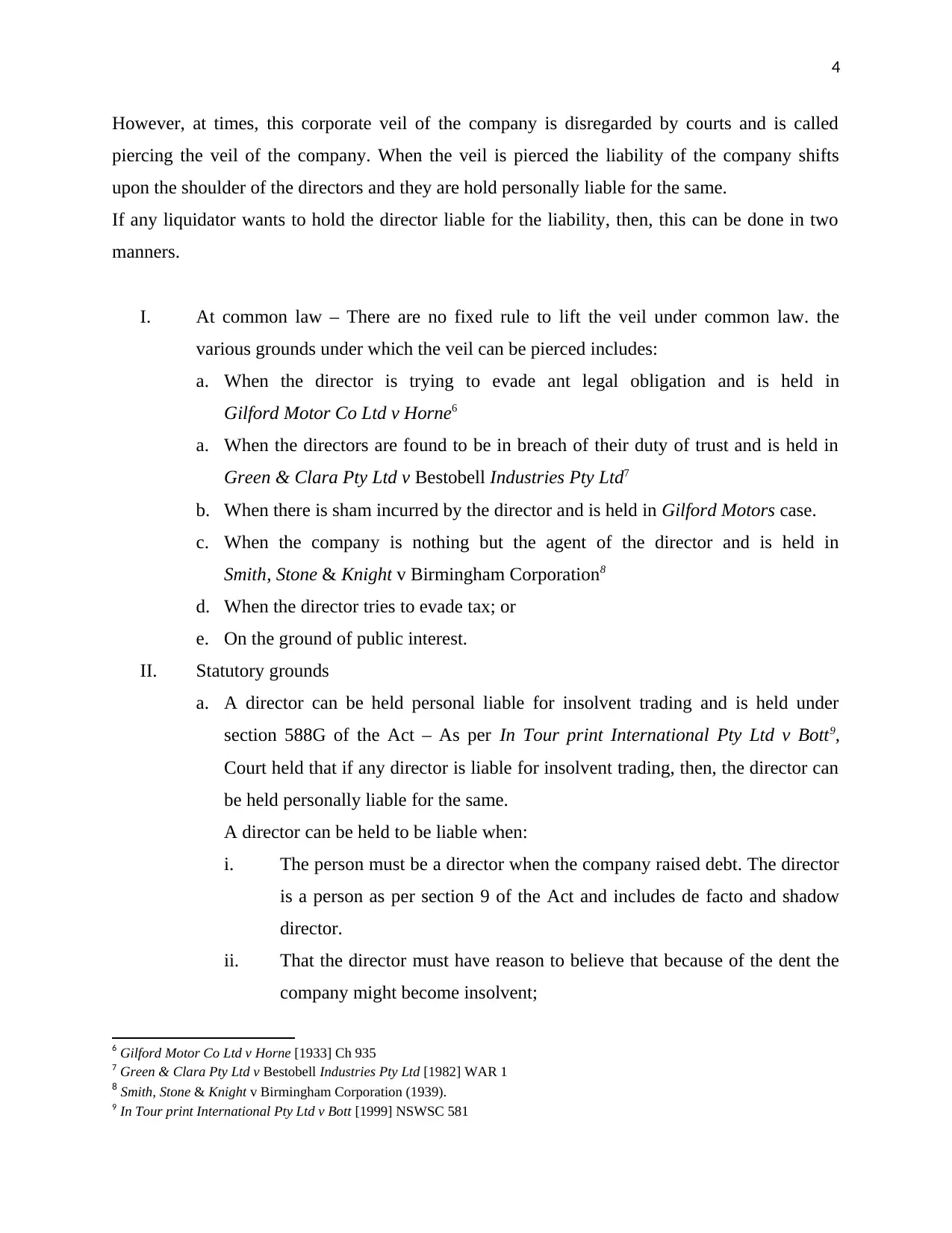
4
However, at times, this corporate veil of the company is disregarded by courts and is called
piercing the veil of the company. When the veil is pierced the liability of the company shifts
upon the shoulder of the directors and they are hold personally liable for the same.
If any liquidator wants to hold the director liable for the liability, then, this can be done in two
manners.
I. At common law – There are no fixed rule to lift the veil under common law. the
various grounds under which the veil can be pierced includes:
a. When the director is trying to evade ant legal obligation and is held in
Gilford Motor Co Ltd v Horne6
a. When the directors are found to be in breach of their duty of trust and is held in
Green & Clara Pty Ltd v Bestobell Industries Pty Ltd7
b. When there is sham incurred by the director and is held in Gilford Motors case.
c. When the company is nothing but the agent of the director and is held in
Smith, Stone & Knight v Birmingham Corporation8
d. When the director tries to evade tax; or
e. On the ground of public interest.
II. Statutory grounds
a. A director can be held personal liable for insolvent trading and is held under
section 588G of the Act – As per In Tour print International Pty Ltd v Bott9,
Court held that if any director is liable for insolvent trading, then, the director can
be held personally liable for the same.
A director can be held to be liable when:
i. The person must be a director when the company raised debt. The director
is a person as per section 9 of the Act and includes de facto and shadow
director.
ii. That the director must have reason to believe that because of the dent the
company might become insolvent;
6 Gilford Motor Co Ltd v Horne [1933] Ch 935
7 Green & Clara Pty Ltd v Bestobell Industries Pty Ltd [1982] WAR 1
8 Smith, Stone & Knight v Birmingham Corporation (1939).
9 In Tour print International Pty Ltd v Bott [1999] NSWSC 581
However, at times, this corporate veil of the company is disregarded by courts and is called
piercing the veil of the company. When the veil is pierced the liability of the company shifts
upon the shoulder of the directors and they are hold personally liable for the same.
If any liquidator wants to hold the director liable for the liability, then, this can be done in two
manners.
I. At common law – There are no fixed rule to lift the veil under common law. the
various grounds under which the veil can be pierced includes:
a. When the director is trying to evade ant legal obligation and is held in
Gilford Motor Co Ltd v Horne6
a. When the directors are found to be in breach of their duty of trust and is held in
Green & Clara Pty Ltd v Bestobell Industries Pty Ltd7
b. When there is sham incurred by the director and is held in Gilford Motors case.
c. When the company is nothing but the agent of the director and is held in
Smith, Stone & Knight v Birmingham Corporation8
d. When the director tries to evade tax; or
e. On the ground of public interest.
II. Statutory grounds
a. A director can be held personal liable for insolvent trading and is held under
section 588G of the Act – As per In Tour print International Pty Ltd v Bott9,
Court held that if any director is liable for insolvent trading, then, the director can
be held personally liable for the same.
A director can be held to be liable when:
i. The person must be a director when the company raised debt. The director
is a person as per section 9 of the Act and includes de facto and shadow
director.
ii. That the director must have reason to believe that because of the dent the
company might become insolvent;
6 Gilford Motor Co Ltd v Horne [1933] Ch 935
7 Green & Clara Pty Ltd v Bestobell Industries Pty Ltd [1982] WAR 1
8 Smith, Stone & Knight v Birmingham Corporation (1939).
9 In Tour print International Pty Ltd v Bott [1999] NSWSC 581
Secure Best Marks with AI Grader
Need help grading? Try our AI Grader for instant feedback on your assignments.
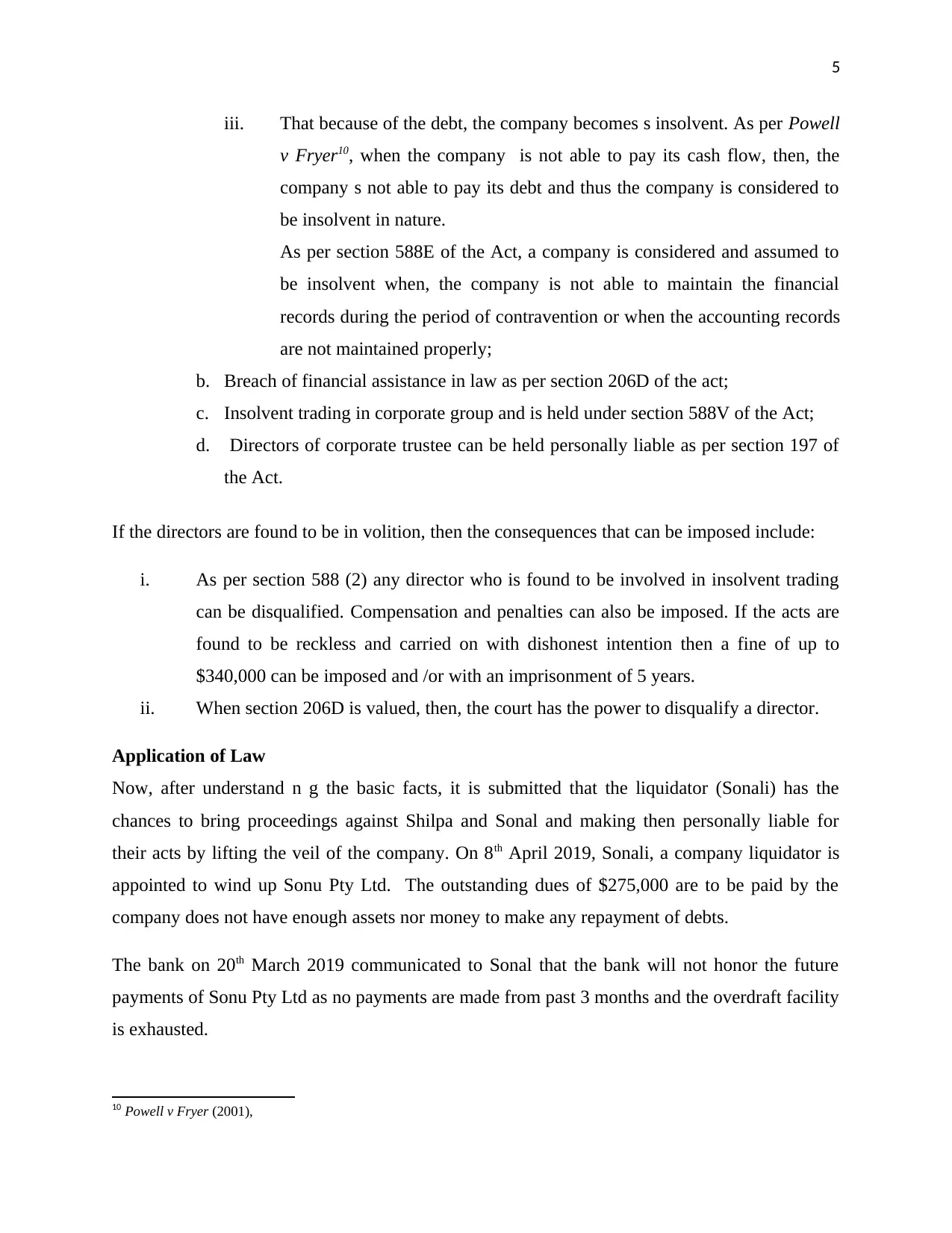
5
iii. That because of the debt, the company becomes s insolvent. As per Powell
v Fryer10, when the company is not able to pay its cash flow, then, the
company s not able to pay its debt and thus the company is considered to
be insolvent in nature.
As per section 588E of the Act, a company is considered and assumed to
be insolvent when, the company is not able to maintain the financial
records during the period of contravention or when the accounting records
are not maintained properly;
b. Breach of financial assistance in law as per section 206D of the act;
c. Insolvent trading in corporate group and is held under section 588V of the Act;
d. Directors of corporate trustee can be held personally liable as per section 197 of
the Act.
If the directors are found to be in volition, then the consequences that can be imposed include:
i. As per section 588 (2) any director who is found to be involved in insolvent trading
can be disqualified. Compensation and penalties can also be imposed. If the acts are
found to be reckless and carried on with dishonest intention then a fine of up to
$340,000 can be imposed and /or with an imprisonment of 5 years.
ii. When section 206D is valued, then, the court has the power to disqualify a director.
Application of Law
Now, after understand n g the basic facts, it is submitted that the liquidator (Sonali) has the
chances to bring proceedings against Shilpa and Sonal and making then personally liable for
their acts by lifting the veil of the company. On 8th April 2019, Sonali, a company liquidator is
appointed to wind up Sonu Pty Ltd. The outstanding dues of $275,000 are to be paid by the
company does not have enough assets nor money to make any repayment of debts.
The bank on 20th March 2019 communicated to Sonal that the bank will not honor the future
payments of Sonu Pty Ltd as no payments are made from past 3 months and the overdraft facility
is exhausted.
10 Powell v Fryer (2001),
iii. That because of the debt, the company becomes s insolvent. As per Powell
v Fryer10, when the company is not able to pay its cash flow, then, the
company s not able to pay its debt and thus the company is considered to
be insolvent in nature.
As per section 588E of the Act, a company is considered and assumed to
be insolvent when, the company is not able to maintain the financial
records during the period of contravention or when the accounting records
are not maintained properly;
b. Breach of financial assistance in law as per section 206D of the act;
c. Insolvent trading in corporate group and is held under section 588V of the Act;
d. Directors of corporate trustee can be held personally liable as per section 197 of
the Act.
If the directors are found to be in volition, then the consequences that can be imposed include:
i. As per section 588 (2) any director who is found to be involved in insolvent trading
can be disqualified. Compensation and penalties can also be imposed. If the acts are
found to be reckless and carried on with dishonest intention then a fine of up to
$340,000 can be imposed and /or with an imprisonment of 5 years.
ii. When section 206D is valued, then, the court has the power to disqualify a director.
Application of Law
Now, after understand n g the basic facts, it is submitted that the liquidator (Sonali) has the
chances to bring proceedings against Shilpa and Sonal and making then personally liable for
their acts by lifting the veil of the company. On 8th April 2019, Sonali, a company liquidator is
appointed to wind up Sonu Pty Ltd. The outstanding dues of $275,000 are to be paid by the
company does not have enough assets nor money to make any repayment of debts.
The bank on 20th March 2019 communicated to Sonal that the bank will not honor the future
payments of Sonu Pty Ltd as no payments are made from past 3 months and the overdraft facility
is exhausted.
10 Powell v Fryer (2001),
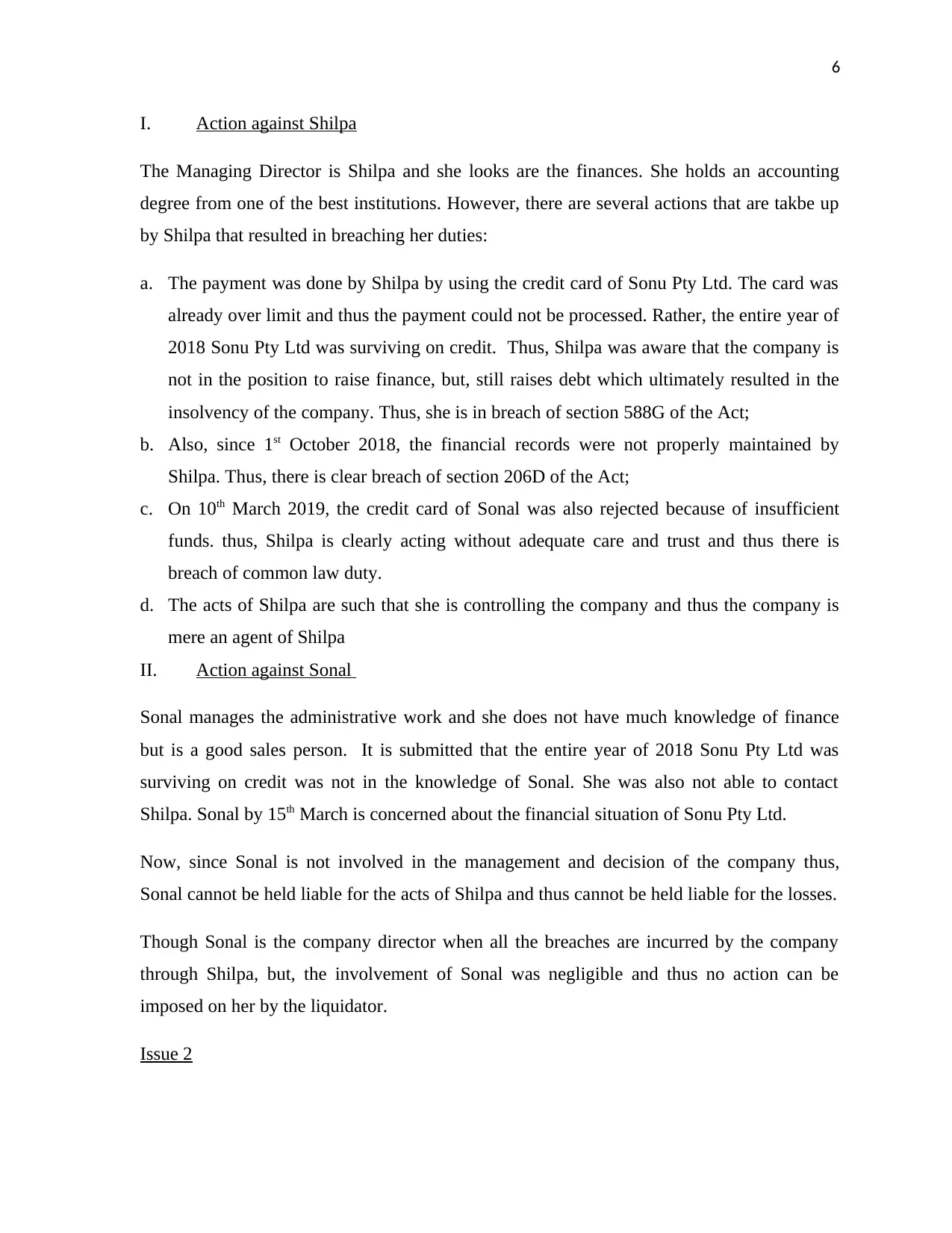
6
I. Action against Shilpa
The Managing Director is Shilpa and she looks are the finances. She holds an accounting
degree from one of the best institutions. However, there are several actions that are takbe up
by Shilpa that resulted in breaching her duties:
a. The payment was done by Shilpa by using the credit card of Sonu Pty Ltd. The card was
already over limit and thus the payment could not be processed. Rather, the entire year of
2018 Sonu Pty Ltd was surviving on credit. Thus, Shilpa was aware that the company is
not in the position to raise finance, but, still raises debt which ultimately resulted in the
insolvency of the company. Thus, she is in breach of section 588G of the Act;
b. Also, since 1st October 2018, the financial records were not properly maintained by
Shilpa. Thus, there is clear breach of section 206D of the Act;
c. On 10th March 2019, the credit card of Sonal was also rejected because of insufficient
funds. thus, Shilpa is clearly acting without adequate care and trust and thus there is
breach of common law duty.
d. The acts of Shilpa are such that she is controlling the company and thus the company is
mere an agent of Shilpa
II. Action against Sonal
Sonal manages the administrative work and she does not have much knowledge of finance
but is a good sales person. It is submitted that the entire year of 2018 Sonu Pty Ltd was
surviving on credit was not in the knowledge of Sonal. She was also not able to contact
Shilpa. Sonal by 15th March is concerned about the financial situation of Sonu Pty Ltd.
Now, since Sonal is not involved in the management and decision of the company thus,
Sonal cannot be held liable for the acts of Shilpa and thus cannot be held liable for the losses.
Though Sonal is the company director when all the breaches are incurred by the company
through Shilpa, but, the involvement of Sonal was negligible and thus no action can be
imposed on her by the liquidator.
Issue 2
I. Action against Shilpa
The Managing Director is Shilpa and she looks are the finances. She holds an accounting
degree from one of the best institutions. However, there are several actions that are takbe up
by Shilpa that resulted in breaching her duties:
a. The payment was done by Shilpa by using the credit card of Sonu Pty Ltd. The card was
already over limit and thus the payment could not be processed. Rather, the entire year of
2018 Sonu Pty Ltd was surviving on credit. Thus, Shilpa was aware that the company is
not in the position to raise finance, but, still raises debt which ultimately resulted in the
insolvency of the company. Thus, she is in breach of section 588G of the Act;
b. Also, since 1st October 2018, the financial records were not properly maintained by
Shilpa. Thus, there is clear breach of section 206D of the Act;
c. On 10th March 2019, the credit card of Sonal was also rejected because of insufficient
funds. thus, Shilpa is clearly acting without adequate care and trust and thus there is
breach of common law duty.
d. The acts of Shilpa are such that she is controlling the company and thus the company is
mere an agent of Shilpa
II. Action against Sonal
Sonal manages the administrative work and she does not have much knowledge of finance
but is a good sales person. It is submitted that the entire year of 2018 Sonu Pty Ltd was
surviving on credit was not in the knowledge of Sonal. She was also not able to contact
Shilpa. Sonal by 15th March is concerned about the financial situation of Sonu Pty Ltd.
Now, since Sonal is not involved in the management and decision of the company thus,
Sonal cannot be held liable for the acts of Shilpa and thus cannot be held liable for the losses.
Though Sonal is the company director when all the breaches are incurred by the company
through Shilpa, but, the involvement of Sonal was negligible and thus no action can be
imposed on her by the liquidator.
Issue 2
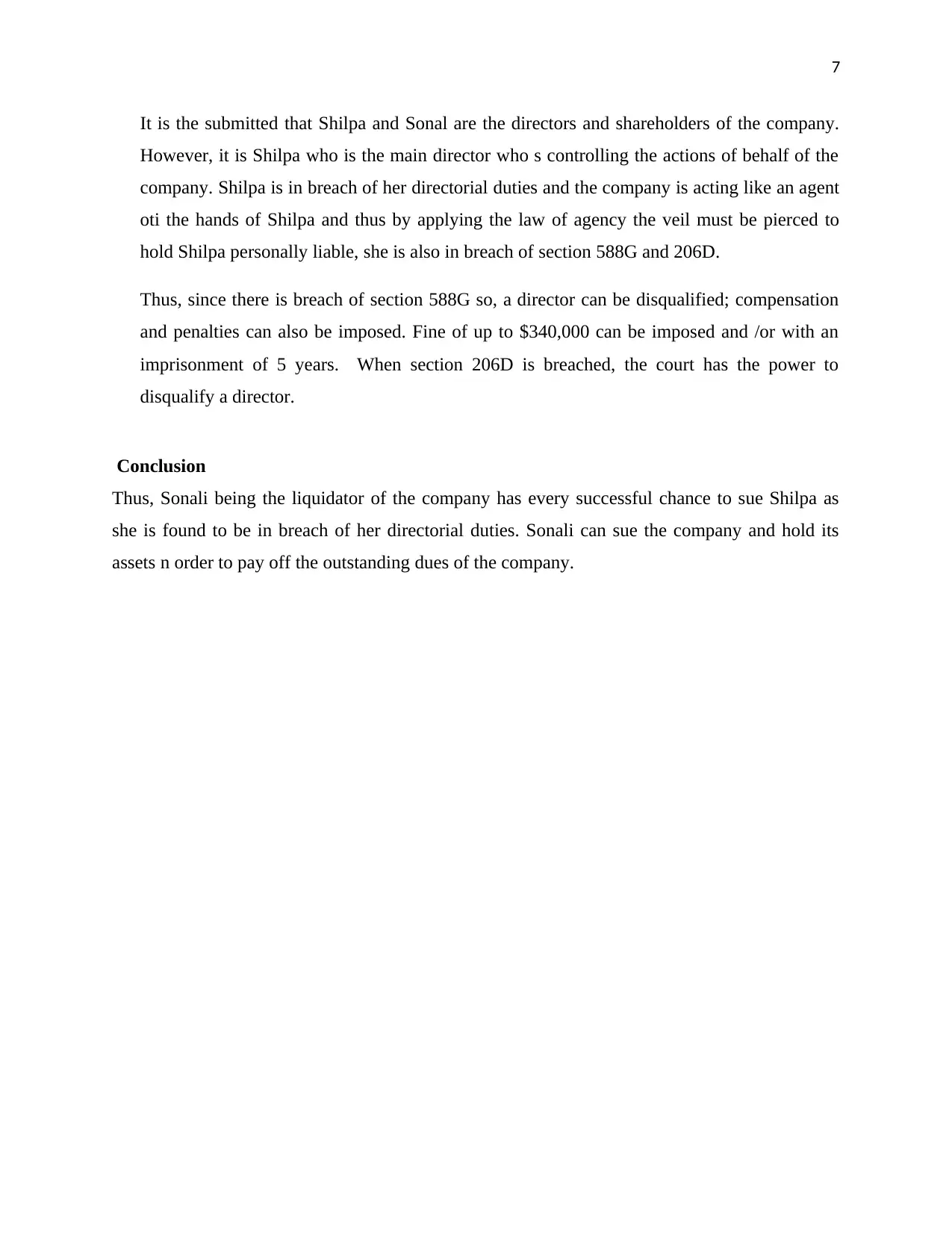
7
It is the submitted that Shilpa and Sonal are the directors and shareholders of the company.
However, it is Shilpa who is the main director who s controlling the actions of behalf of the
company. Shilpa is in breach of her directorial duties and the company is acting like an agent
oti the hands of Shilpa and thus by applying the law of agency the veil must be pierced to
hold Shilpa personally liable, she is also in breach of section 588G and 206D.
Thus, since there is breach of section 588G so, a director can be disqualified; compensation
and penalties can also be imposed. Fine of up to $340,000 can be imposed and /or with an
imprisonment of 5 years. When section 206D is breached, the court has the power to
disqualify a director.
Conclusion
Thus, Sonali being the liquidator of the company has every successful chance to sue Shilpa as
she is found to be in breach of her directorial duties. Sonali can sue the company and hold its
assets n order to pay off the outstanding dues of the company.
It is the submitted that Shilpa and Sonal are the directors and shareholders of the company.
However, it is Shilpa who is the main director who s controlling the actions of behalf of the
company. Shilpa is in breach of her directorial duties and the company is acting like an agent
oti the hands of Shilpa and thus by applying the law of agency the veil must be pierced to
hold Shilpa personally liable, she is also in breach of section 588G and 206D.
Thus, since there is breach of section 588G so, a director can be disqualified; compensation
and penalties can also be imposed. Fine of up to $340,000 can be imposed and /or with an
imprisonment of 5 years. When section 206D is breached, the court has the power to
disqualify a director.
Conclusion
Thus, Sonali being the liquidator of the company has every successful chance to sue Shilpa as
she is found to be in breach of her directorial duties. Sonali can sue the company and hold its
assets n order to pay off the outstanding dues of the company.
Paraphrase This Document
Need a fresh take? Get an instant paraphrase of this document with our AI Paraphraser
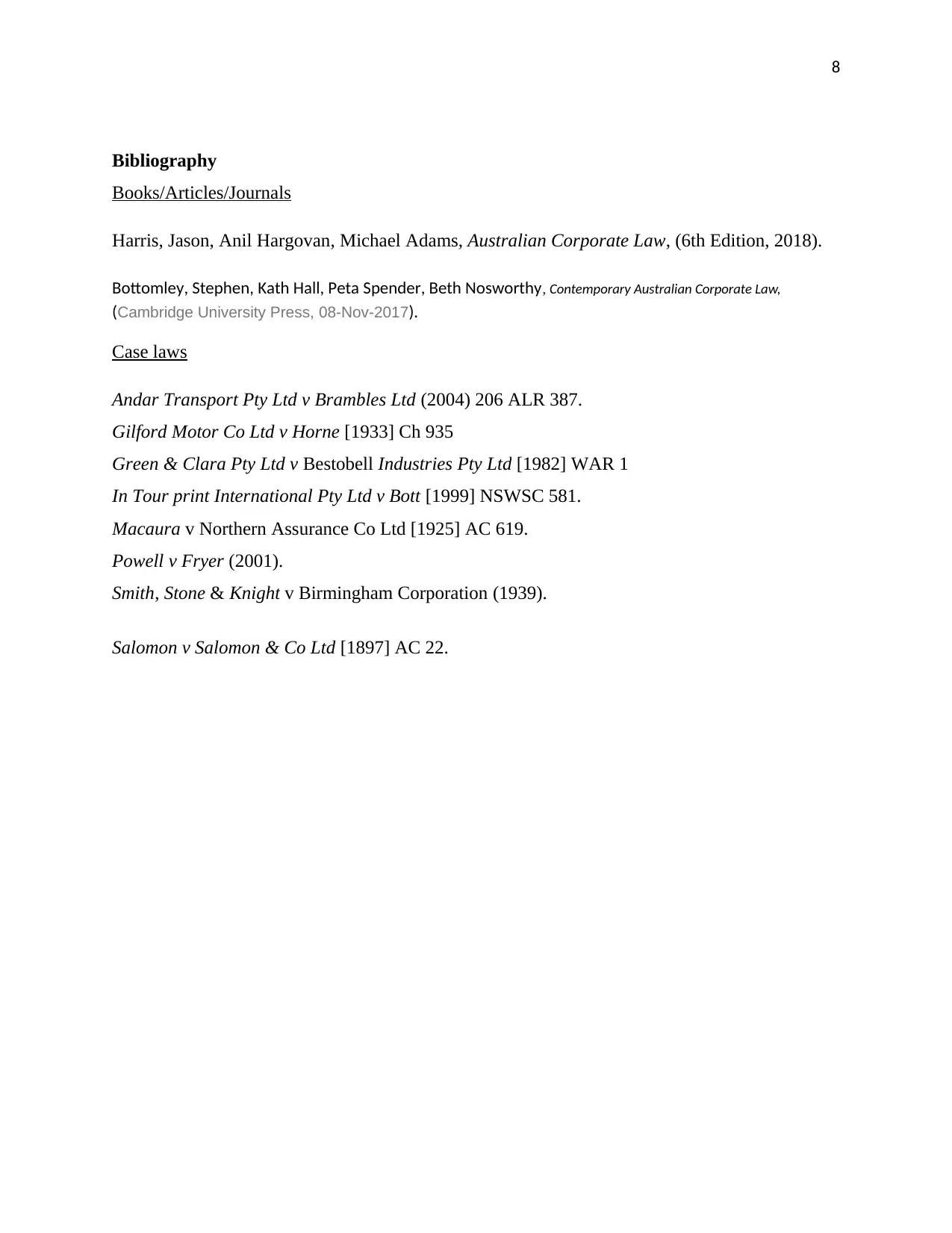
8
Bibliography
Books/Articles/Journals
Harris, Jason, Anil Hargovan, Michael Adams, Australian Corporate Law, (6th Edition, 2018).
Bottomley, Stephen, Kath Hall, Peta Spender, Beth Nosworthy, Contemporary Australian Corporate Law,
(Cambridge University Press, 08-Nov-2017).
Case laws
Andar Transport Pty Ltd v Brambles Ltd (2004) 206 ALR 387.
Gilford Motor Co Ltd v Horne [1933] Ch 935
Green & Clara Pty Ltd v Bestobell Industries Pty Ltd [1982] WAR 1
In Tour print International Pty Ltd v Bott [1999] NSWSC 581.
Macaura v Northern Assurance Co Ltd [1925] AC 619.
Powell v Fryer (2001).
Smith, Stone & Knight v Birmingham Corporation (1939).
Salomon v Salomon & Co Ltd [1897] AC 22.
Bibliography
Books/Articles/Journals
Harris, Jason, Anil Hargovan, Michael Adams, Australian Corporate Law, (6th Edition, 2018).
Bottomley, Stephen, Kath Hall, Peta Spender, Beth Nosworthy, Contemporary Australian Corporate Law,
(Cambridge University Press, 08-Nov-2017).
Case laws
Andar Transport Pty Ltd v Brambles Ltd (2004) 206 ALR 387.
Gilford Motor Co Ltd v Horne [1933] Ch 935
Green & Clara Pty Ltd v Bestobell Industries Pty Ltd [1982] WAR 1
In Tour print International Pty Ltd v Bott [1999] NSWSC 581.
Macaura v Northern Assurance Co Ltd [1925] AC 619.
Powell v Fryer (2001).
Smith, Stone & Knight v Birmingham Corporation (1939).
Salomon v Salomon & Co Ltd [1897] AC 22.
1 out of 8
Related Documents
Your All-in-One AI-Powered Toolkit for Academic Success.
+13062052269
info@desklib.com
Available 24*7 on WhatsApp / Email
![[object Object]](/_next/static/media/star-bottom.7253800d.svg)
Unlock your academic potential
© 2024 | Zucol Services PVT LTD | All rights reserved.




